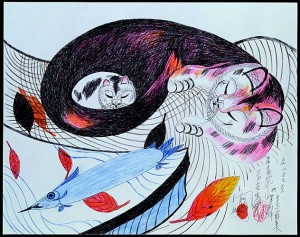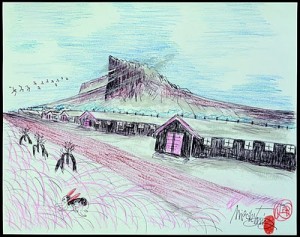
I recently discovered a documentary entitled “The Cats of Mirikitani.” While preparing to write about it, I took a peek at the film’s trailer. It has no words of introduction – only music. It makes perfect sense once you see this film, as it will leave you without words and perhaps only a very full heart and a need for a box of tissues! It is hard to describe the power of the story of Tsutomo (Jimmy) Mirikitani and his journey to healing from the pain of war, loss and homelessness. Here is the short trailer:
I stumbled across “The Cats of Mirikitani,” which tells the true story of Jimmy Mirikitani, a Japanese American artist, who becomes homeless in New York City. The tragedy of 9/11 provided an opportunity for him to build trust with a local filmmaker, Linda Hattendorf. As time marched on, Hattendorf helped to peel back the layers of Mirikitani’s life. Through this incredible film, we discover that Mirikitani, born in California and therefore a US citizen, was put in a Japanese interment camp for 3 1/2 years during the war. He was pressured to renounce his US citizenship. Although he ended up homeless, he continued to draw while living on the streets of lower Manhattan. Hattendorf lived around the corner from his usual hang out and she regularly filmed 80 year old Mirikitani and his drawings in the months before 9/11.
On September 11th, the planes hit the towers and Mirikitani again addressed his emotions through art. He drew the tragedy of the towers just as he drew the pain of the internment camp at Tule Lake and the devastation of Hiroshima. And when the toxic dust fell across lower Manhattan, Hattendorf searched the streets for Miritakani and invited him to stay with her in her tiny apartment. She continued to film him as they shared the same space.
We realize, as the film progresses, that his life story has lived in the art that he has drawn every day for years – the significance of the cats, the mountain, the persimmons. With each scene of trust building between Mirikitani and Hattendorf, we learn more about the tragedy of an artist’s career being stolen from him by the forced internment, the family that he lost in both Hiroshima and the US, the pain and anger that he lives with, and how his art kept him going.

I won’t give away the ending, but I will strongly suggest that you have a handkerchief nearby! I will say that the power of Hattendorf’s humanity and the beauty of this aging artist’s soul develop into an incredible tale that yields many life lessons. Here is what this film made me ponder:
1) Behind the eyes of a homeless person is a life that I know nothing about – and when I don’t know about something or someone, I should ask and learn.
2) September 11, 2001 and December 7, 1941 are two dates that will live in our history books. How we have responded to those two dates is increasingly important. We learned in time that Japanese internment camps were simply cruel and unjust. Perhaps we will also explore the idea that demonizing all of Islam for the acts of a handful of terrorists is also cruel and unjust.
3) Art has the power to heal. Time has the power to heal. Place has the power to heal. Compassion has the power to heal. The most unlikely combination of people possible – a “40-something” film maker and an 80 year old homeless man – they have the power to move mountains.
This is a film that should be used in the classroom. It is appropriate for high school and college level students, and can be used in any of the following disciplines: Sociology, Social Work, Cross-Cultural Communication, History, Film, Politics, Art, Art Therapy, and more.
Mirikitani’s work will be on display from January 15 – March 26, 2011 at the Japanese Canadian National Museum in Crescent Burnaby, BC (Canada).
I’ll simply close with Jimmy Mirikitani’s favorite expression, “Make Art, Not War!”
